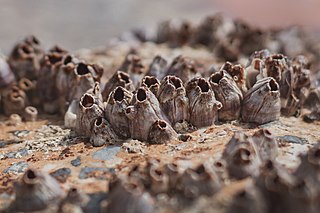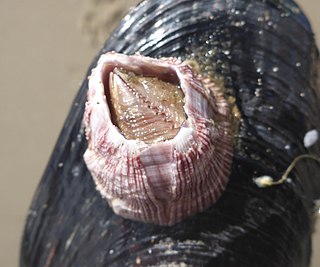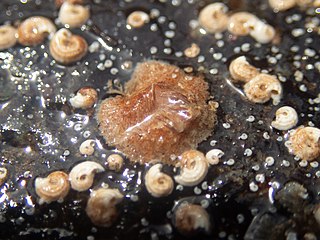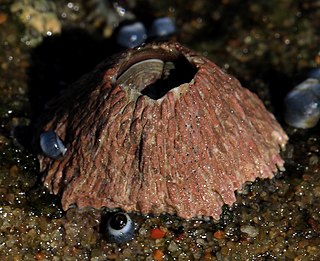
Balanus is a genus of barnacles in the family Balanidae of the subphylum Crustacea.

Thoracica is an infraclass of crustaceans which contains the most familiar species of barnacles found on rocky coasts, such as Semibalanus balanoides and Chthamalus stellatus. They have six well-developed limbs, and may be either stalked or sessile. The carapace is heavily calcified. The group includes free-living and commensal species.

Thecostraca is a class of marine invertebrates containing over 2,200 described species. Many species have planktonic larvae which become sessile or parasitic as adults.

Henry Augustus Pilsbry was an American biologist, malacologist and carcinologist, among other areas of study. He was a dominant presence in many fields of invertebrate taxonomy for the better part of a century. For much of his career, his authority with respect to the classification of certain substantial groups of organisms was unchallenged: barnacles, chitons, North American terrestrial mollusks, and others.

The Balanidae comprise a family of barnacles of the order Balanomorpha. As a result of research published in 2021 by Chan et al., the members of the family Archaeobalanidae were merged with this family.

The Balanomorpha are an order of barnacles, containing familiar acorn barnacles of the seashore. The order contains these families:

Megabalanus is a genus of barnacles in the family Balanidae. Members of the genus grow to 7 cm (2.8 in) in length and inhabit the lower intertidal zone.

Chthamalus is a genus of barnacles that is found along almost all non-boreal coasts of the northern hemisphere, as well as many regions in the southern hemisphere. These small barnacles have been studied in part because of the taxonomic confusion over a group of species that, by and large, are morphologically and ecologically quite similar. In recent years, molecular techniques have identified a number of cryptic species that have been subsequently confirmed by taxonomists using morphological measurements. Most recently the genus has been shown to be paraphyletic, with the genus Microeuraphia nested within Chthamalus.

Notochthamalus scabrosus, the only species in the genus Notochthamalus, is a species of barnacle found along the south-western and south-eastern coasts of South America, from Peru to the Falkland Islands. The species is found almost exclusively higher in the intertidal zone than the mussel Perumytilus, often codistributed with the confamilial barnacle Jehlius cirratus and Balanus flosculus.

Megabalanus californicus, the California barnacle, is a species of large barnacle in the family Balanidae. It is native to rocky coasts in the Eastern Pacific Ocean from North California to the Gulf of California.

Tetraclita is a genus of sessile barnacles in the family Tetraclitidae. There are more than 20 described species in Tetraclita.

Tetraclitidae is a family of sessile barnacles in the order Balanomorpha. There are about 10 genera and more than 50 described species in Tetraclitidae.

Megabalanus azoricus, the Azorean barnacle, is a species of large barnacle in the family Balanidae. It is endemic to Macaronesia: the Azores, Madeira, the Canary Islands, and Cape Verde. It is the largest and third most common shallow water barnacle of the Azores, where it is heavily exploited for food and has a high commercial value since the colonization of the islands. It was included in the 100 species for priority management within Macaronesia. It is a thoracopodal filter feeder and the majority are hermaphrodites. It is more abundant in the first 3 m (9.8 ft) on the low intertidal and infralittoral rocky shores. The empty shells of the barnacles are a vital habitat for the blennies Parablennius ruber, P. incognitus and Coryphoblennius galerita as they provide shelter and substrata for egg deposition during reproduction. A large number of invertebrate species also use the empty shells. Although present throughout the archipelago, it is more abundant in the eastern islands. It has a genetic similarity with Megabalanus tintinnabulum. Some crucial features of the M. azoricus species are digonic hermaphroditism in sessile adults, development of planktotrophic larvae, dependence on exposed rocky shores in the intertidal habitat, and insular distribution restricted to the northeastern Atlantic oceanic islands.

Verrucidae is a family of asymmetrical sessile barnacles in the order Verrucomorpha. There are about 14 genera and more than 90 described species in Verrucidae.

Verrucomorpha is an order of asymmetrical sessile barnacles in the class Thecostraca. They are typically found in deeper and deep-sea habitats. There are 2 families and more than 100 described species in Verrucomorpha.

Tetraclita serrata, the grey volcano barnacle, is a species of symmetrical sessile barnacle in the family Tetraclitidae. It is found in Africa.

Tetraclita stalactifera, the ribbed barnacle, is a species of symmetrical sessile barnacle in the family Tetraclitidae. It is found in the western Atlantic Ocean.

Tetraclita japonica, the Japanese volcano barnacle, Kurofujitsubo, is a species of symmetrical sessile barnacle in the family Tetraclitidae.

Tetraclita rufotincta is a species of symmetrical sessile barnacle in the family Tetraclitidae.

Microeuraphia is a genus of star barnacles in the family Chthamalidae. There are about eight described species in Microeuraphia.


















